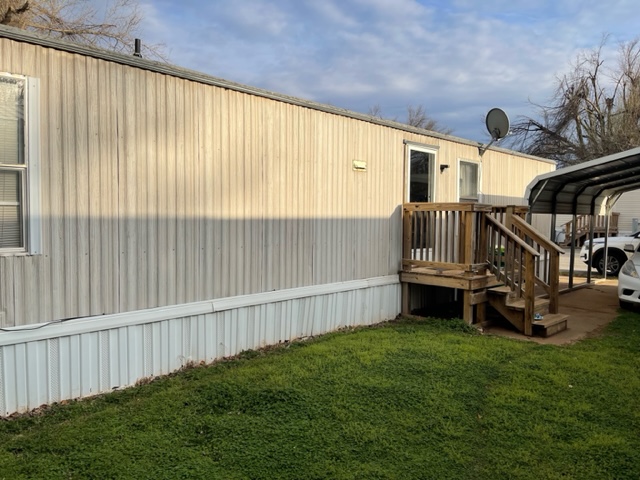When it comes to owning mobile homes, there are two common scenarios:
- Renting a mobile home within a mobile home community or
- Purchasing a mobile home situated in a park
This dual scenario provides flexibility in homeownership options and unlocks a realm of unique advantages.
The standout benefit of living in a mobile home park is its affordability. With the cost of housing on the rise, and limited budgets, finding a space that’s both comfortable and cost-saving can be difficult.
Mobile home parks step in as a solution, presenting spacious living areas, energy efficiency, and wallet-friendly rental fees. It emerges as a practical alternative, effectively catering to the increasing demand for economical housing options.
In this blog, we explore how much it costs to live in a mobile home park, the recent rent hikes faced by mobile homeowners, and strategies to navigate through these challenging times.
Mobile Home Park Lot Rent – What’s Included?
What is Lot Rent?
Lot rent, also known as land rent, is a common term used to describe the monthly fee that individuals or families pay to reside in a mobile home park. In some cases, this fee may be paid quarterly, depending on the specific arrangement.
Lot rent primarily covers the cost of leasing the space for the mobile home but can include various services and amenities provided by the mobile home park.
It typically covers upkeep for communal areas, including roadways and green spaces, while also granting access to shared amenities like playgrounds, pools, and community centers. Moreover, it might include essential utility hookups for water, sewage, and electricity, although the specifics can vary from park to park.
However, notable concern revolves around the consistent escalation of lot rent. These increments generally range between 4 and 6 percent annually, increasing the financial load for individuals and families alike. The continuous rise in rent poses a substantial hurdle, particularly for those seeking cost-effective housing solutions.
Regrettably, most states lack specific regulations curbing the extent of lot rent hikes.
This absence of oversight grants park owners the liberty to adjust rent rates as they see fit, which often leads to substantial spikes that strain the financial resources of mobile homeowners. The absence of transparency further worsens the situation of lack of accessible data about precise costs or specific rate changes tied to lot rents.
Adding to the complexity is the scarcity of information concerning the exact amounts mobile homeowners pay for the land beneath their residences. This makes pinpointing an exact figure for lot rent payment or tracking how these figures have evolved over time quite challenging.
Utilities in the Mobile Home Park
Depending on the mobile home park, you might encounter an all-inclusive rent or incur extra fees for utilities. Many mobile home parks’ rental agreement covers certain utilities like water, electricity, and cable, while others have separate bills.
Beyond rent, Homeowner Association (HOA) fees may arise in specific mobile home parks. They are used to maintain communal areas within the park, ensuring a pleasant environment for all residents.
In numbers, a mobile home park owner could demand roughly $400 per month for the plot of land under your mobile home. Depending on park policy, this sum might cover public utilities.
Nevertheless, if utilities aren’t included, you would need to account for added costs of up to $375 per month to cover them. Also, certain parks might mandate a one-time setup fee of about $100. It’s worth factoring in when planning your budget.
Remember that park owners and operators face escalating costs themselves, encompassing utilities, workers’ wages, and property taxes. These factors lead to increased rents for lots within the mobile home park, causing concerns about affordability.
Factors Influencing Rent Cost at a Mobile Home Park
1. Location & Demand
This mirrors standard real estate. For instance, a mobile home park in California might command a monthly rent of approximately $800, while in Florida, rates as minimal as $300 could be uncovered. It’s all about supply and demand, and the desirability of the location.
2. Sizes
Larger lots naturally command higher rents. Additionally, some parks include utilities in the rent, while others charge them separately. It’s crucial to clarify this before signing a lease.
3. Amenities
Many mobile home parks offer a range of amenities, from swimming pools and fitness centers to community halls and playgrounds. Some parks include these in the rent, while others charge extra, almost like a members-only club. Be sure to factor this into your budget.
4. Moving costs
If you’re bringing your own mobile home into the park, there could be costs associated with moving and positioning it. And if you need to move it within the park later on, that could incur additional costs too.
5. Hidden fees
Watch out for additional fees. These could include PO box rental, registration fees, and insurance policies. If you own a mobile home on a private piece of land, be aware of extra monthly utility costs.
6. Land demand and legal protections
Finally, keep in mind that today’s land is increasingly in demand for other projects, leading to potential rent hikes or lease changes. Unfortunately, mobile home park residents often have limited protections under a patchwork of state laws.
It’s always a good idea to consult with a real estate professional or legal advisor to understand your rights and potential risks.
How Much is the Rent in a Mobile Home Park?
Several factors come into play when we consider the cost of living in a mobile home park, including location and specific lot features.
The affordability stands out, ranging from as low as $150 to approximately $800 per month. This contrast sets mobile home park rent apart from the steep averages seen in traditional apartment rentals, which can easily reach $2000 per month.
Average Monthly Lot Rent
On average, the monthly lot rent hovers around $400. The extent of services included in this fee varies: some mobile home parks encompass public utilities within the rent, while others necessitate an additional fee to cover these amenities.
Reviewing the lease agreement is crucial to understanding what your lot rent encompasses, ensuring you’re not overpaying for services that could be obtained more affordably elsewhere, or even for free.
Variation in rent by location
The cost of living in a mobile home park is different from state to state.
For instance, states like Kansas or South Carolina are some of the most affordable, boasting an average lot rent of $200 per month. Conversely, in areas with elevated living standards like California, $700 isn’t out of the picture.
Recommended states for mobile home park living
If a full-time mobile home park lifestyle is on your radar, consider exploring states like Florida, Texas, and South Dakota. These states are well-known for their lack of income tax, translating to greater financial advantages and more disposable income to improve your mobile home park experience. Additionally, Nevada and Washington present ample open spaces, enabling a more cost-effective search for suitable land for your mobile home.
Estimating rent costs
If you’d like an estimate of your prospective rent expenses, practical tools such as the MHP Space Rent Calculator can prove invaluable. This resource aids in projecting monthly rent costs based on specific parameters, offering a clearer financial outlook.
Additional expenses and considerations
While certain states offer economical living in mobile home parks, it’s important to note potential additional costs.
Transporting a mobile home into or out of a park, though not reaching Californian levels, remains a notable expense, ranging from $6,000 to $14,000. For owners of double-wide homes, see our article: “How Much Does it Cost to Remove a Double-wide Mobile Home?”
Taxes also have some influence on the cost dynamics of residing in a mobile home park. If you own only the mobile home, you might be subject to personal property tax payments to your state’s motor vehicle department, although certain states do not execute this. Conversely, if you own the land, property taxes are a certainty.
Rent control policies can also impact the cost to live in a mobile home park. In certain cases, the city may impose limits on the rent charged by the park, preventing it from exceeding the city-mandated rate. However, rent increases may not always be fully controlled, which can raise concerns among mobile homeowners.
Can a Mobile Home Park Increase Lot Rent?
Yes, a mobile home park can increase rent.
However, most areas have laws protecting residents by ensuring their right to live in the park under the existing lease terms. While new park owners may want to raise rent, these protections typically remain in place until the current lease expires.
Despite these safeguards, lot rent hikes are an ongoing issue for many. Recent reports show increases of 10-25%, with some doubling or tripling payments. These massive hikes place huge financial strain on residents.
Mobile homeowners might have protection, but it’s not enough. In worst cases, steep rent increases force residents from their homes.
Residents must know their rights and seek legal advice if rents seem unfairly raised. Advocacy groups and legal aid can help.
Struggling with mobile home park costs? Donate your mobile home for a tax deduction and stress-free removal. Contact Banyan today!
Living within a mobile home park offers a budget-conscious alternative to conventional housing.
The financial advantages are evident, encompassing minimized initial expenditures, decreased property taxes, and reasonably priced monthly installments. Nonetheless, it’s crucial to remain alert in light of the ever-evolving landscape surrounding this housing alternative.
In recent years, a substantial surge in rental costs and accompanying fees has manifested across various US states. In the last two years, Banyan has observed many tenants being pushed out of mobile home parks due to steep increases in lot rent. This trend is evident regardless of whether the park is undergoing upgrades or simply requires additional funds for operations.
Since 2019, these expenses have nearly doubled, generating concern among many mobile home proprietors. The genuine concern of being confronted with affordability challenges for their residences is an issue resonating with countless residents, and relocation isn’t always viable.
Moving a mobile home comes with a substantial price tag, with costs potentially soaring to $15,000. This financial hurdle can make you feel stuck in your current park, despite the mounting expenses. Moreover, not all mobile homes qualify for relocation, leading to additional complexities.
For individuals unable to shift their mobile homes, the option of donation emerges as a brilliant course of action. By choosing this path, you can alleviate the burden of financial strain while simultaneously contributing shelter to those in need. Banyan Mobile Home Removal is a duly accredited 501(c)(3) nonprofit organization that offers a seamless mobile home donation process. Donating enables you to part with a well-maintained mobile home that has become financially overwhelming to keep, all the while enjoying tax benefits matching the home’s market value. What’s more, our services include free relocation. Contact us today to begin this journey.


